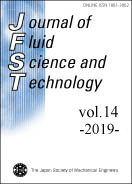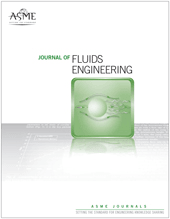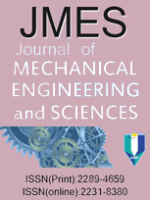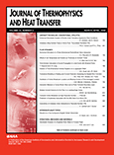
FDMP-Fluid Dynamics & Materials Processing
Scope & Guideline
Exploring the Nexus of Fluid Dynamics and Material Innovation
Introduction
Aims and Scopes
- Fluid Dynamics:
The journal extensively covers topics related to fluid behavior, including turbulence, multiphase flows, and heat transfer, often leveraging computational fluid dynamics (CFD) for simulations. - Material Processing:
Research on the processing of various materials, including concrete, polymers, and composites, is a core area. This includes studies on mechanical properties, durability, and innovative material formulations. - Numerical and Experimental Approaches:
A strong emphasis is placed on integrating numerical simulations with experimental validations, allowing for comprehensive analyses of fluid dynamics and material interactions. - Environmental and Energy Applications:
The journal explores the application of fluid dynamics in environmental engineering and energy systems, such as renewable energy technologies and pollution control. - Nanofluids and Advanced Materials:
There is a notable focus on nanotechnology and the development of advanced materials, particularly in the context of enhancing thermal and mechanical properties.
Trending and Emerging
- Computational Fluid Dynamics (CFD) Innovations:
There is a growing trend in utilizing advanced CFD techniques, including machine learning and artificial intelligence, to enhance simulation accuracy and efficiency in fluid dynamics. - Sustainable and Green Materials:
Research on sustainable materials, particularly those that incorporate waste or environmentally friendly components, is on the rise as industries seek to reduce their ecological footprint. - Nanotechnology in Fluid Dynamics:
The use of nanofluids in various applications, including heat transfer and energy efficiency, is increasingly prominent, highlighting the intersection of nanotechnology and fluid dynamics. - Energy Efficiency in Fluid Systems:
Emerging themes focus on optimizing energy use in fluid systems, including renewable energy applications and energy recovery methods, reflecting global sustainability efforts. - Advanced Manufacturing Techniques:
Research into innovative manufacturing processes, such as 3D printing and additive manufacturing, is gaining traction, particularly in the context of complex fluid-material interactions.
Declining or Waning
- Traditional Material Processing Techniques:
Research on conventional material processing methods has declined as interest shifts toward more innovative and sustainable practices, such as the use of nanomaterials and composites. - Single-Phase Flow Analysis:
Studies focused solely on single-phase flow dynamics are becoming less prominent as the journal emphasizes more complex multiphase and non-Newtonian fluid dynamics. - Basic Theoretical Fluid Dynamics:
Theoretical analyses without practical applications or experimental validation are seeing reduced publication rates, indicating a preference for applied research. - Low-Impact Environmental Studies:
Research focusing on low-impact or non-urgent environmental studies appears to be waning, as more urgent and impactful environmental issues gain attention.
Similar Journals

JOURNAL OF ENHANCED HEAT TRANSFER
Transforming Heat Transfer Knowledge into Practical ApplicationsThe JOURNAL OF ENHANCED HEAT TRANSFER, published by BEGELL HOUSE INC, is a prominent resource for researchers and professionals in the fields of mechanical engineering, fluid flow and transfer processes, and condensed matter physics. With a history spanning from 1993 to 2024, this journal offers a platform for disseminating cutting-edge research and innovations that enhance our understanding of heat transfer phenomena. Although it operates under a traditional subscription model, its impressive standing is underscored by its Scopus rankings—positioned within the 59th percentile for Mechanical Engineering and 58th percentile for Fluid Flow and Transfer Processes. Additionally, it holds Q2 and Q3 categorizations in relevant fields, reflecting its importance in advancing knowledge and applications in heat transfer technology. This journal effectively bridges the gap between theoretical insights and practical solutions, making it an indispensable tool for academics, industrial practitioners, and students eager to explore advancements in thermal management and efficiency.

Experimental and Computational Multiphase Flow
Exploring the Dynamics of Multiphase FlowExperimental and Computational Multiphase Flow, published by SpringerNature, is a prestigious academic journal that critically examines advancements in the field of fluid dynamics, with a specialized focus on multiphase flow phenomena. Since its inception in 2019, the journal has established a remarkable reputation, attaining Q1 status in Fluid Flow and Transfer Processes as well as Mechanical Engineering according to the 2023 category quartiles, reflecting its high impact and relevance in these domains. With Scopus rankings placing it among the top 15 journals in both Chemical Engineering and Nuclear Energy and Engineering, Experimental and Computational Multiphase Flow is an essential resource for researchers, professionals, and students engaged in cutting-edge studies and applications. Although it operates on a subscription model, the journal remains dedicated to disseminating high-quality research and fostering a deeper understanding of complex fluid interactions across various scientific disciplines. By prioritizing innovative methodologies and interdisciplinary collaborations, the journal aims to significantly contribute to the ongoing evolution of multiphase flow research, recognizing its critical importance in engineering and energy sectors.

Journal of Fluid Science and Technology
Empowering Engineers with Open Access KnowledgeThe Journal of Fluid Science and Technology, published by the Japan Society of Mechanical Engineers, serves as a pivotal platform for the dissemination of cutting-edge research in the fields of fluid mechanics and mechanical engineering. With an ISSN of 1880-5558, this Open Access journal has been dedicated to advancing the understanding of fluid flow and transfer processes since its establishment. As of 2023, it holds a significant position with a Q3 quartile ranking in both Fluid Flow and Transfer Processes and Mechanical Engineering categories. Researchers and practitioners are encouraged to explore the journal’s extensive collection of articles, contributing to the body of knowledge that impacts various practical applications in engineering and technology. The journal, which has established a reputation for quality amidst a competitive landscape, further fosters international collaboration and education by providing unrestricted access to its content. For professionals and students alike, the Journal of Fluid Science and Technology represents an invaluable resource for the latest findings and innovations in fluid dynamics and mechanical systems.

Propulsion and Power Research
Unlocking Innovations in Aerospace and Automotive Engineering.Propulsion and Power Research, published by KEAI PUBLISHING LTD, is a leading Open Access journal that has been advancing the field of propulsion and power systems since its inception in 2012. With its commitment to fostering scientific discourse and innovation, the journal has gained a prominent position within academia, achieving a Q1 ranking in multiple categories such as Aerospace Engineering, Automotive Engineering, and Fluid Flow and Transfer Processes as of 2023. With an impressive ranking of #18 out of 153 in Aerospace Engineering and consistent recognition in the Scopus rankings, the journal explores critical advancements and research findings that propel the industry forward. As an Open Access publication, it ensures that groundbreaking research is readily available to a broad audience, enhancing collaboration between researchers, practitioners, and students. The journal's scope encompasses a wide range of topics within propulsion and energy solutions, making it an essential resource for anyone keen on discovering significant developments in this dynamic field.

International Journal of Turbomachinery Propulsion and Power
Advancing the frontiers of turbomachinery and propulsion.The International Journal of Turbomachinery Propulsion and Power, published by MDPI, is a pivotal scholarly platform devoted to advancing the field of turbomachinery, propulsion technology, and power systems. Since its inception in 2016, this open-access journal has provided an invaluable resource for researchers, professionals, and students within the realms of Aerospace Engineering, Energy Engineering, and Mechanical Engineering. With its current ranking in the Q3 category across these disciplines and its strategic placement in Scopus, the journal facilitates the dissemination of cutting-edge research findings and innovative solutions. The commitment to open access, effective from 2017, ensures that high-quality research is readily accessible, fostering collaboration and knowledge sharing in the global academic community. As it continues to expand its scope through 2024, the journal remains a crucial avenue for discussion, experimentation, and advancement in turbomachinery and energy-related studies.

Interfacial Phenomena and Heat Transfer
Unveiling the Complexities of Interfacial DynamicsInterfacial Phenomena and Heat Transfer is a leading academic journal published by BEGELL HOUSE INC that has rapidly established itself as an essential resource for scholars and industry experts in the fields of engineering, fluid flow, and chemical processes. With an ISSN of 2169-2785 and E-ISSN 2167-857X, this journal focuses on the critical interdisciplinary aspects of heat transfer and interfacial phenomena, offering insights that span across mechanical engineering, chemical engineering, and physical sciences. Despite its relatively recent inception in 2017, it has garnered respectable recognition, with a 2023 Scopus rank placing it in the Q3 category within the disciplines of Engineering (miscellaneous) and Fluid Flow and Transfer Processes, making it a pertinent publication for those interested in cutting-edge research. As researchers and professionals navigate the complexities of interfacial dynamics, Interfacial Phenomena and Heat Transfer serves as a pivotal platform, publishing high-quality, peer-reviewed articles that aim to advance knowledge and stimulate further investigation in this increasingly vital domain.

JOURNAL OF FLUIDS ENGINEERING-TRANSACTIONS OF THE ASME
Pioneering Innovations in Fluid MechanicsJOURNAL OF FLUIDS ENGINEERING-TRANSACTIONS OF THE ASME, published by the renowned American Society of Mechanical Engineers (ASME), stands as a pivotal platform for disseminating cutting-edge research in the field of mechanical engineering, specifically focusing on fluid mechanics and its diverse applications. With an established history dating back to 1897, this journal features research that pushes the boundaries of knowledge and technology in areas such as fluid dynamics, thermal engineering, and hydrodynamics. Although it is not an open-access journal, it maintains rigorous peer-review standards, ensuring the publication of high-quality scholarly articles that contribute to the academic and professional community. In the latest rankings, it holds a respectable position within the Q2 category of mechanical engineering journals, reflecting its significant impact, as evidenced by its Scopus rank of #204 out of 672, placing it in the 69th percentile. Researchers, professionals, and students alike will find this journal to be a vital resource for the latest developments and innovative insights in fluids engineering.

Journal of Mechanical Engineering and Sciences
Fostering Collaboration in Mechanical Engineering DiscoursesThe Journal of Mechanical Engineering and Sciences (ISSN: 2289-4659, E-ISSN: 2231-8380), published by UNIV MALAYSIA PAHANG, is a prominent open access journal established in 2011, dedicated to advancing the field of mechanical engineering and associated sciences. Covering a wide array of topics from industrial manufacturing processes to computational mechanics, the journal serves as a vital platform for researchers, professionals, and students to disseminate innovative findings and methodologies. With impressive Scopus rankings, including a place in the 60th percentile for Industrial and Manufacturing Engineering, the journal holds a significant position among its peers, facilitating global academic discourse. Located in Kuantan, Pahang, Malaysia, the journal emphasizes accessibility and collaboration within the engineering community, encouraging submissions that contribute to both theoretical and applied aspects of mechanical engineering.

JOURNAL OF THERMOPHYSICS AND HEAT TRANSFER
Catalyzing Insights into Fluid Flow and Heat TransferJOURNAL OF THERMOPHYSICS AND HEAT TRANSFER, published by the American Institute of Aeronautics and Astronautics, serves as a vital platform for the dissemination of cutting-edge research in the fields of thermophysics and heat transfer. With an ISSN of 0887-8722 and an E-ISSN of 1533-6808, this journal has been pivotal in enhancing our understanding of heat transfer mechanisms since its inception in 1987, continuing through 2024. It occupies a noteworthy position in various academic categories, boasting Q2 rankings in both Fluid Flow and Transfer Processes and Mechanical Engineering, reflecting its significant contribution to the engineering and physical sciences community. Although it currently does not offer Open Access options, the journal’s repository of rigorous peer-reviewed articles remains accessible to researchers, professionals, and students eager to expand their knowledge and apply innovative findings in aerospace, condensed matter physics, and planetary sciences. Emphasizing both theoretical and experimental approaches, the JOURNAL OF THERMOPHYSICS AND HEAT TRANSFER remains an indispensable resource for advancing the frontiers of engineering and applied sciences.

Acta Mechanica et Automatica
Elevating Knowledge in Mechanical Engineering and AutomationActa Mechanica et Automatica is a leading open-access journal published by SCIENDO, dedicated to the dynamic fields of Mechanical Engineering and Control and Systems Engineering. Since its inception in 2012, this journal has provided a vital platform for researchers and professionals to disseminate innovative findings and advances within these disciplines, boasting a convergence of years up to 2024. Based in Warsaw, Poland, the journal has embraced open access since 2013, ensuring broad dissemination of knowledge for the academic community globally. With a current Scopus ranking placing it in the 25th to 31st percentile among its peers, it plays an essential role in fostering scholarly communication and collaboration. The objectives of Acta Mechanica et Automatica include promoting original research, facilitating dialogue between disciplines, and enhancing the understanding of complex mechanical and control systems. This journal is invaluable for researchers looking to explore cutting-edge methodologies, theories, and applications in engineering.